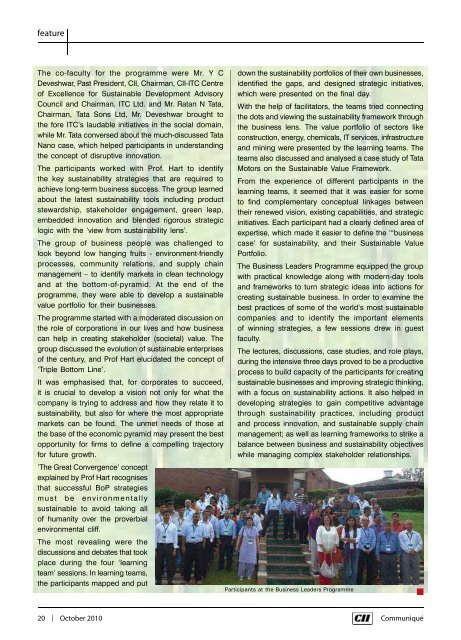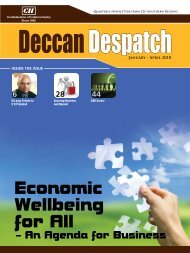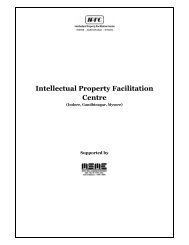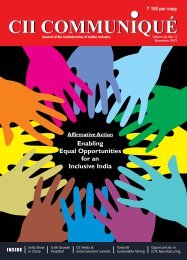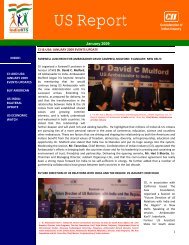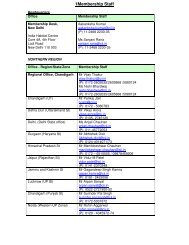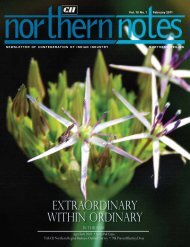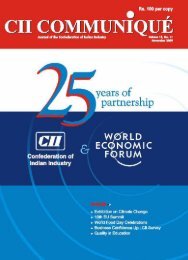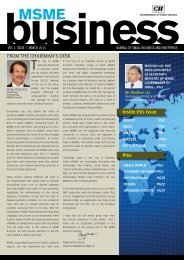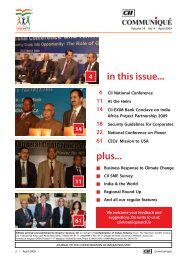CII Communique - October, 2010
CII Communique - October, 2010
CII Communique - October, 2010
- No tags were found...
Create successful ePaper yourself
Turn your PDF publications into a flip-book with our unique Google optimized e-Paper software.
featureThe co-faculty for the programme were Mr. Y CDeveshwar, Past President, <strong>CII</strong>, Chairman, <strong>CII</strong>-ITC Centreof Excellence for Sustainable Development AdvisoryCouncil and Chairman, ITC Ltd. and Mr. Ratan N Tata,Chairman, Tata Sons Ltd, Mr. Deveshwar brought tothe fore ITC’s laudable initiatives in the social domain,while Mr. Tata conversed about the much-discussed TataNano case, which helped participants in understandingthe concept of disruptive innovation.The participants worked with Prof. Hart to identifythe key sustainability strategies that are required toachieve long-term business success. The group learnedabout the latest sustainability tools including productstewardship, stakeholder engagement, green leap,embedded innovation and blended rigorous strategiclogic with the ‘view from sustainability lens’.The group of business people was challenged tolook beyond low hanging fruits - environment-friendlyprocesses, community relations, and supply chainmanagement – to identify markets in clean technologyand at the bottom-of-pyramid. At the end of theprogramme, they were able to develop a sustainablevalue portfolio for their businesses.The programme started with a moderated discussion onthe role of corporations in our lives and how businesscan help in creating stakeholder (societal) value. Thegroup discussed the evolution of sustainable enterprisesof the century, and Prof Hart elucidated the concept of‘Triple Bottom Line’.It was emphasised that, for corporates to succeed,it is crucial to develop a vision not only for what thecompany is trying to address and how they relate it tosustainability, but also for where the most appropriatemarkets can be found. The unmet needs of those atthe base of the economic pyramid may present the bestopportunity for firms to define a compelling trajectoryfor future growth.‘The Great Convergence’ conceptexplained by Prof Hart recognisesthat successful BoP strategiesmust be environmentallysustainable to avoid taking allof humanity over the proverbialenvironmental cliff.The most revealing were thediscussions and debates that tookplace during the four ‘learningteam’ sessions. In learning teams,the participants mapped and putdown the sustainability portfolios of their own businesses,identified the gaps, and designed strategic initiatives,which were presented on the final day.With the help of facilitators, the teams tried connectingthe dots and viewing the sustainability framework throughthe business lens. The value portfolio of sectors likeconstruction, energy, chemicals, IT services, infrastructureand mining were presented by the learning teams. Theteams also discussed and analysed a case study of TataMotors on the Sustainable Value Framework.From the experience of different participants in thelearning teams, it seemed that it was easier for someto find complementary conceptual linkages betweentheir renewed vision, existing capabilities, and strategicinitiatives. Each participant had a clearly defined area ofexpertise, which made it easier to define the ‘“businesscase’ for sustainability, and their Sustainable ValuePortfolio.The Business Leaders Programme equipped the groupwith practical knowledge along with modern-day toolsand frameworks to turn strategic ideas into actions forcreating sustainable business. In order to examine thebest practices of some of the world’s most sustainablecompanies and to identify the important elementsof winning strategies, a few sessions drew in guestfaculty.The lectures, discussions, case studies, and role plays,during the intensive three days proved to be a productiveprocess to build capacity of the participants for creatingsustainable businesses and improving strategic thinking,with a focus on sustainability actions. It also helped indeveloping strategies to gain competitive advantagethrough sustainability practices, including productand process innovation, and sustainable supply chainmanagement; as well as learning frameworks to strike abalance between business and sustainability objectiveswhile managing complex stakeholder relationships.Participants at the Business Leaders Programme20 | <strong>October</strong> <strong>2010</strong> Communiqué


